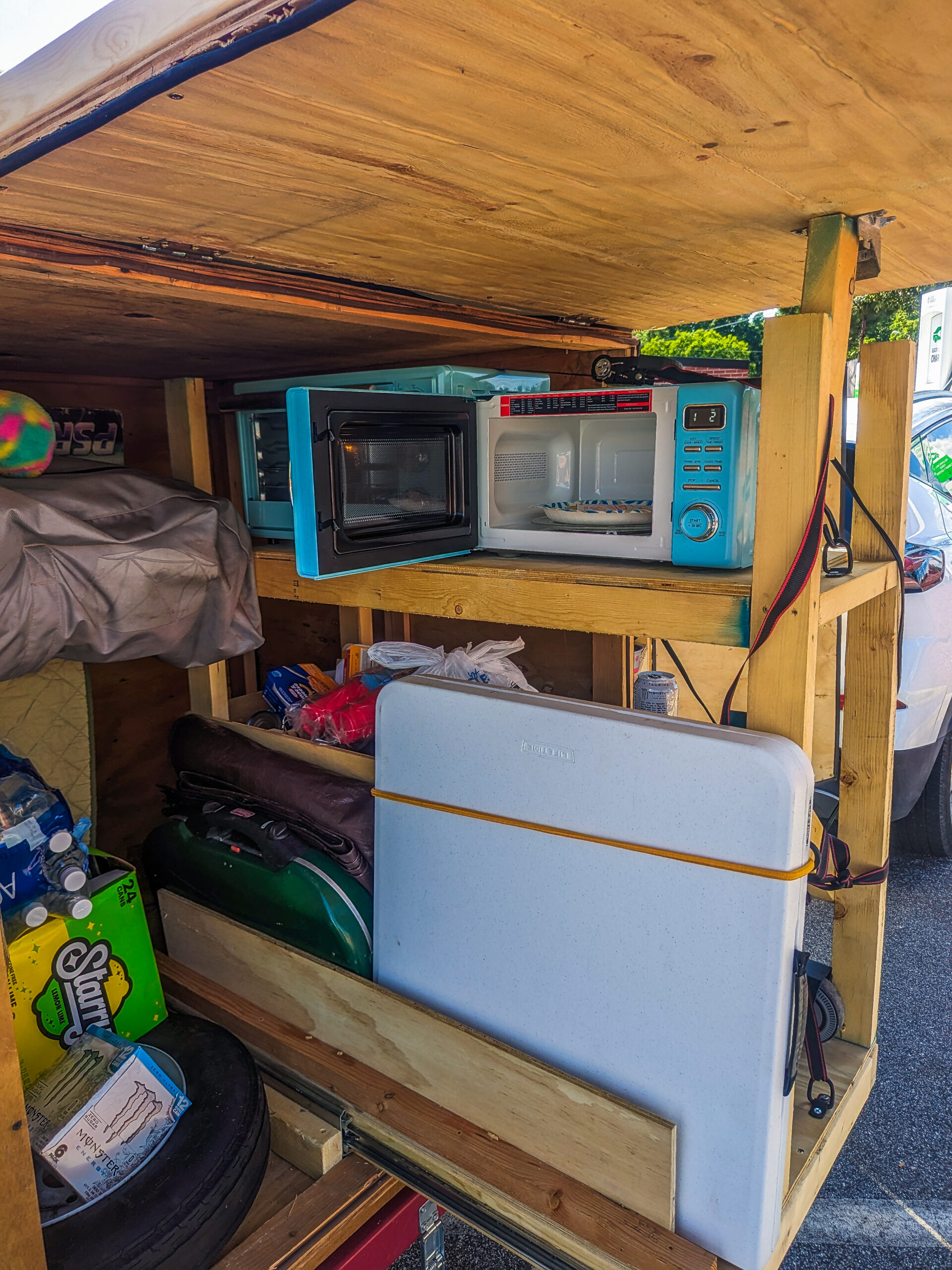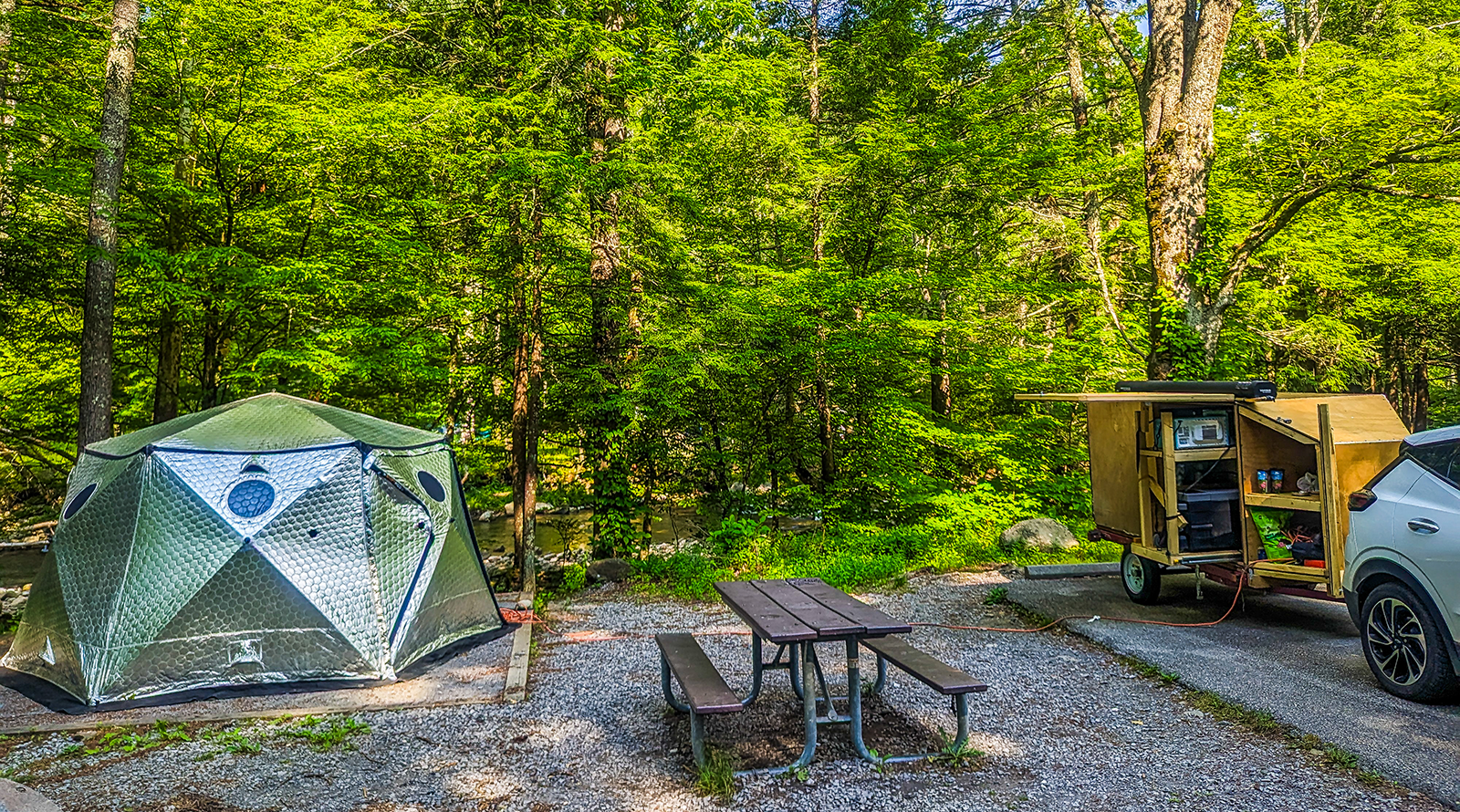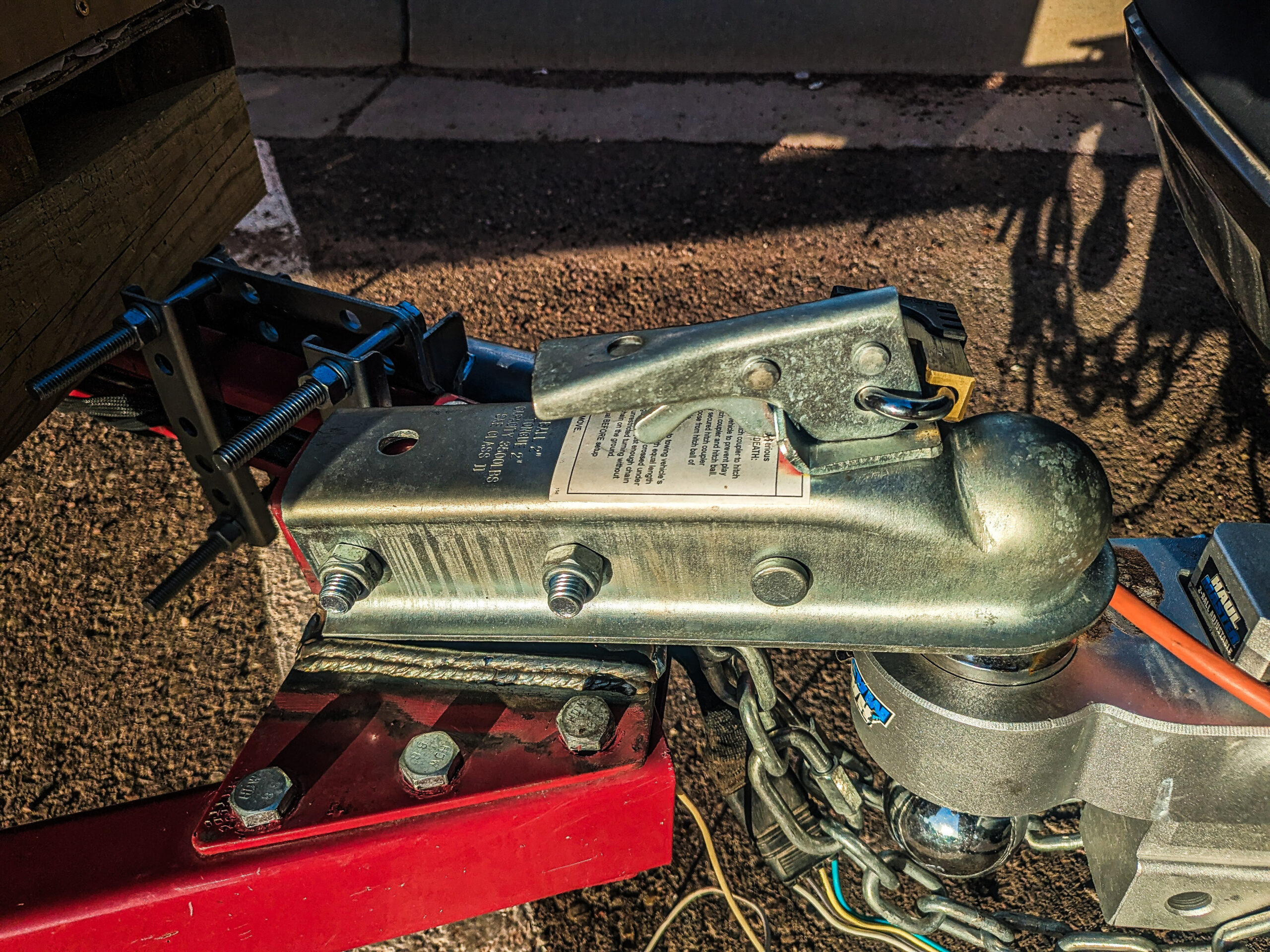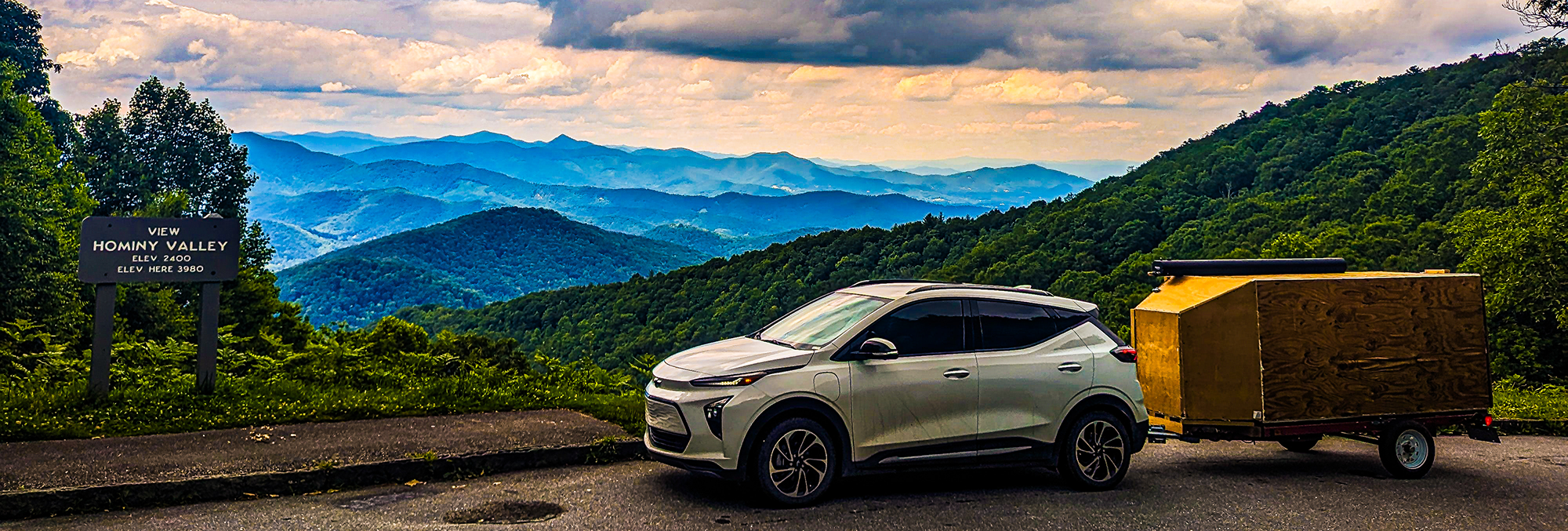I’m not afraid to admit that the Chevrolet Bolt and Bolt EUV aren’t known for being great road trip cars. For me, it was what I could afford when I needed to switch vehicles, and it’s head-and-shoulders better than the overheating Nissan LEAF I had before. Sure, it only charges at 55 kW, but it does it consistently. It also has plenty of range to make it to the next charger in most cases.
But, what happens when you cut the range of the Bolt EUV by about 30%? That’s not as great, but I still managed to have a great trip!
My Camping/Cargo Trailer Setup
Before I tell everyone about the trip, I want to briefly go over the trailer I built for this purpose. You can get a lot more detail from my article over at CleanTechnica if you want to see how I built it, etc.

In short, it’s a wooden cargo box built on top of a Harbor Freight 4×8 trailer. On my first trip, things didn’t go very well, so I had to add safe places to keep things like my Jackery 3000 Pro, EcoFlow Glacier freezer/fridge, oven, and microwave. I built a custom slide-out kitchen to hold everything but the Jackery, which I placed in a sloping box on the tongue.
All of this is powered by a 2000w inverter that draws from the Bolt EUV’s 12v battery, which gets recharged by the vehicle’s 65 kWh main battery pack. This means that I have the power to make for a very comfortable glamping setup, including air conditioned Shiftpod shelters.

The First Part Of The Trip Was Challenging
The first several days of the trip was hard. I drove across Texas in two and a half days, and found out that I had no idea what the setup’s energy efficiency was really going to be. Based on previous data collected close to home, I thought it would get about 2.5 miles/kWh, but I ended up getting closer to 2. This meant that instead of a 15% drop from my car’s unloaded efficiency (3.01 miles/kWh, with truck tires), I ended up losing about 30% range.
This meant having to completely re-plan everything mid-trip. I was originally going to drive to both North Carolina and Michigan for two press events, but it wasn’t going to be possible to get to both in time with the extra charging stops and time.
I also found out that it wasn’t great at keeping water out, wasn’t good at staying closed while going down the road, and that the Harbor Freight tires would wear out in only 1600 miles when going 65 MPH. This made for some tough days, temporary fixes with paracord, and replacing the tires in a national park! I also nearly ran out of charge the first night and ran the vehicle dead about 3/4 of a mile shy of a charger in Sweetwater, Texas.

I did see some great things along the way, though. We visited Hot Springs National Park, and got to see an innovative small business in Arkansas that provides EV charging. We also went through the Great Smoky Mountains and saw many other great sights along the way.
Upgrades and The Trip Home
While staying with family in North Carolina, I managed to fix up several of the problems.
First off, I fixed up the water leak issue. Adding a bunch of screws to tighten the boards to the side of the trailer, caulking all joints, and upgrading the doors made the problem of flapping doors and rain getting on pillows go away.

On the way back, I took about half of the Blue Ridge Parkway. I started out in Boone, North Carolina and then spent the next three days taking it easy along the route. Along the way, we visited Grandfather Mountain, Asheville, and ended up at Great Smoky Mountains National Park.
This part of the trip went very well. The mountainous terrain of the Blue Ridge Parkway generally means less range, but the slow speeds and the regenerative braking both when approaching turns and going down slopes made for great range. I only had to charge in Asheville to get enough juice to make it all the way to the end of the road in Cherokee, NC (just outside Great Smoky Mountains).
The Last Couple Days Sucked, But The Trailer’s Stronger Than Ever
I had to head home via Oklahoma instead of Texas, largely because there’s just not enough EV charging between Dallas and El Paso yet. On flat ground, the Bolt would have been fine, but there’s a climb as you leave Hill Country and the Permian Basin and go to the high deserts near El Paso.
The trip through Arkansas and Oklahoma went pretty well, as there were reasonably good cheap hotels (it was too hot to set up camp) and lots of EV charging. Along this stretch, I saw what a benefit EV charging stations spaced close together can be, as even with the trailer, I was able to charge from 10-60% on many stretches and spent a lot less time at chargers.
But, once I got back into New Mexico at Clovis, all hell broke loose. I forgot to turn the inverter off when I went to bed, and the vehicle’s 12v battery got depleted. It was easily jumped, but the vehicle wouldn’t start even with enough juice. After struggling to arrange to take the Bolt to a dealer for an hour, I tried disconnecting the 12v battery to reset the computer, and things worked again.
Then, I saw that the trailer’s coupler was peeling off of the tongue. Two poorly-done Chinese welds were to blame. Had it come completely apart, both the coupler and the safety chains would have detached from the tongue, leaving the trailer free to do whatever the laws of physics dictated. So, we had to spend several hours finding a welding shop that could fix it up and reinforce it a bit to prevent it from happening again.

Finally, the tires were about bald by this time (again), and we had to replace them. Normal tire shops didn’t have that size or anything else to fit the trailer in stock, so we had to go to Harbor Freight again and buy the crappy tires a third time to get home.
While all this was going on, we didn’t know that an unusually hot and dry part of the forest between us and home had been set ablaze by some poor people who knew they’d get a job putting out the fire. Because it was drier and hotter than previous years (climate change), this created a wild blaze that burnt right into a town, prompting the evacuation of thousands of people. These people, in turn, took up all of the hotels in the region.
We were fortunate to find a hotel about an hour in the wrong direction, and even then it was a terrible place to sleep (it was a “vintage” motel in poor repair). But, as they say, “Any port in a storm.”
Final Thoughts
All in all, the Bolt EUV did a great job being pressed into service doing a job it wasn’t intended for. The vehicle had no problems at all towing an 1800 lb trailer (including cargo) for all of that distance. The only issue we encountered at all was that the Bolt cuts back on cooling when it gets below 25%. This never was an issue until we drove up some hills in 103F heat on the last day as we approached our next charging station. Even then, it only charged slowly for a couple minutes until the cooling kicked back in, and then charged normally. It never derated motor power at any point in the trip or failed us in any way.
The trailer, being a budget build, needed a good shakedown cruise to reveal all of its issues. And, with the exception of the tires, we’ve managed to roll with all of those punches and come away with a better trailer than we started with.
I’d really like to get a vehicle that’s better for towing, but that’s going to have to wait a 2-3 years. Until then, I think the Bolt EUV and the trailer we’re improving will continue to do a great job!

